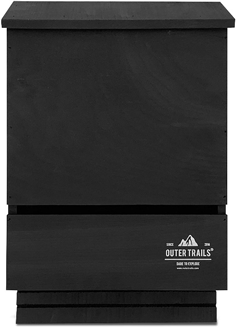How Can We Help Our Local Bats?
The best way we can help local bats is to leave them alone (unless you are a WNS researcher, but even then, they know it is best not to disturb hibernating bats). That means avoiding caves and other areas that are hibernation sites. As part of the endangered species plan for little brown bats, known hibernation locations are often covered with a “bat gate” to prevent human entry. Disturbing hibernation, especially in a colony infected with WNS, can lead to even more bat deaths. If bats are discovered roosting in a building and need to be removed, they should be relocated rather than killed (which in some states is illegal as bats may be a protected species).
Bat Roosting Box Construction
Many people build or purchase bat roosting boxes to attract local bats. These can be purchased in various sizes for round $30-$100. Alternatively, one could also construct a bat roosting box for much less money. In one of the unit lessons, students will construct a bat roosting box of their own, either with the teacher to be installed on the school property, or each student can construct their own if you have access to enough materials. There are several videos and online articles that provide blueprints and tips for bat roosting box construction. Ideally you want to replicate a design that is like where bats would normally roost and raise their young in nature – between the bark and the trunk of a tree. There are a few essential components of a bat roosting box that must be included for bats to even consider moving in. Bat boxes must be sealed to retain heat and prevent moisture. The inside wall should not be smooth since bats will need a ledge or ridge to grasp. While some online plans for bat houses use screen stapled to the inner walls but this is not recommended because over time it could rust or tear, therefore making the bat house uninhabitable. A dark color is also preferred to retain more heat. Cedar is an ideal wood since it is naturally rot resistant. The proper placement location is also critical. It should be placed about 15 feet off the ground to help bats avoid predators. A separate pole or installation on the side of a building is ideal. It should be somewhere that receives heat most of the day. If it is too shady, as putting it on a tree trunk might be, then it will not be warm enough to attract bats, tree branches might be a deterrent obstacle, and predators are more likely to find them. Keep in mind that these are spring and summer homes for bats – not the same as the hibernation areas where local bats gather for the winter. A home or school bat roosting box provides a warm, dry, dark shelter for bats to rest during the day and night when they are not out hunting insects.

Figure 5 A bat box similar to the one I purchased on Amazon for about $30.00
Here are two good resources for bat box construction:
www.nwf.org/Garden-for-Wildlife/Cover/Build-a-Bat-House.22
https://www.batcon.org/about-bats/bat-houses.23
In my class, I intend to bring in a purchased bat box and have students analyze and replicate its construction. We will take it apart to see how it is made and use what we learn to design our own.

Comments: